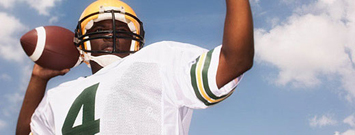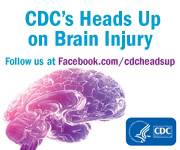Take Concussions Out of Play: Learn to Prevent, Recognize, and Respond to Concussions
 CDC encourages you to take this opportunity to talk with your coaches, parents, athletes, and others about concussion in sports and the steps to take to help prevent, recognize, and respond to this serious injury.
CDC encourages you to take this opportunity to talk with your coaches, parents, athletes, and others about concussion in sports and the steps to take to help prevent, recognize, and respond to this serious injury.
 CDC estimates 173,285 sports- and recreation-related TBIs, including concussions, among children and adolescents are treated in U.S. emergency departments each year.
CDC estimates 173,285 sports- and recreation-related TBIs, including concussions, among children and adolescents are treated in U.S. emergency departments each year.
A bump, blow, or jolt to the head can cause a concussion, a type of TBI. Concussions can also occur from a blow to the body that causes the head to move rapidly back and forth. Even a "ding," "getting your bell rung," or what seems to be mild bump or blow to the head can be serious.
Concussions can occur in any sport or recreation activity. So, all coaches, parents, and athletes need to learn concussion signs and symptoms and what to do if a concussion occurs.
CDC's "Heads Up: Concussion in High School" and "Heads Up: Concussion in Youth Sports" initiatives include materials and information to help coaches of all sports to help identify concussions and take immediate steps to respond when one is suspected.
Prevention and Preparation
Check with your league or school about concussion policies. Concussion policy statements can be developed to include the league or school's commitment to safety, a brief description about concussion, and information on when athletes can safely return to play. Parents and athletes should sign the concussion policy statement before the first practice.
Insist that safety comes first. No one technique or safety equipment is 100 percent effective in preventing concussion, but there are things you can do to help minimize the risks for concussion and other injuries.
For example, to help prevent injuries:
- Enforce no hits to the head or other types of dangerous play.
- Practice safe playing techniques and encourage athletes to follow the rules of play.
- Make sure players wear approved and properly-fitted protective equipment. Protective equipment should be well-maintained and be worn consistently and correctly.
Learn about concussion. Before the first practice, talk your athlete(s) and others about the dangers of concussion and potential long-term consequences of concussion. Review the signs and symptoms of concussion and keep the four-step action plan with you at games and practices.
More Information
- Take the FREE online training for health care professionals
- Take the FREE online training for coaches
- Check out the NFL/CDC posters for young athletes and for NFL players
- Concussion in Sports
- Watch a Video
- NFL Commissioner Promotes Safety in Youth Sports [VIDEO - 4:13 minutes]
- NFL PSA on Concussion Safety [VIDEO - 0:30 seconds]
- Keeping Quiet Can Keep You Out of the Game [VIDEO - 2:00 minutes]
This video tells one young woman's story of sustaining two concussions within a short period of time. Concussion is a serious injury. Athletes, if you think you've had a concussion, don't hide it, report it, and take time to recover. - Keeping Quiet Can Keep You Out of the Game…A Mother's Story [VIDEO - 2:00minutes]
All moms and dads should learn about concussion. In this video, a mom tells her story and wants all parents to know that if they think their child has a concussion, take them out of play and seek the advice of a health care professional. - Managing Return to Play
- Listen to a Radio PSA
- Listen to a podcast
- Send a Health-e-Card
- Download the Tool Kit on Concussion for High School Coaches
- Download the Tool Kit on Concussion for Physicians
- Traumatic Brain Injuries Related to Sports and Recreation Activities Among Persons Aged ≤19 Years — United States, 2001–2009
- Nonfatal Traumatic Brain Injuries from Sports and Recreation Activities — United States, 2001–2005 (MMWR, July 27, 2007)
CDC works 24/7 saving lives and protecting people from health threats to have a more secure nation. A US federal agency, CDC helps make the healthy choice the easy choice by putting science and prevention into action. CDC works to help people live longer, healthier and more productive lives.
Get email updates
To receive email updates about this page, enter your email address:
Contact Us:
- Centers for Disease Control and Prevention
1600 Clifton Rd
Atlanta, GA 30333 - 800-CDC-INFO
(800-232-4636)
TTY: (888) 232-6348 - Contact CDC-INFO




